One of the fundamental features for any productivity tool is a to do list. It is a list of things that you need to accomplish in order to achieve a big goal. The list will consolidate all of your tasks in one place. An efficient to do list can help you set priorities, track your progress, refresh your memory, easy to carry out the tasks in a timely manner.
You don’t have to spend extra on a high-end to do list app with complicated features. The best to do list apps should be simple enough to make your life easier but powerful enough to let you get things done.
Todoist (Windows, macOS, Android, iPhone, iPad, Web)
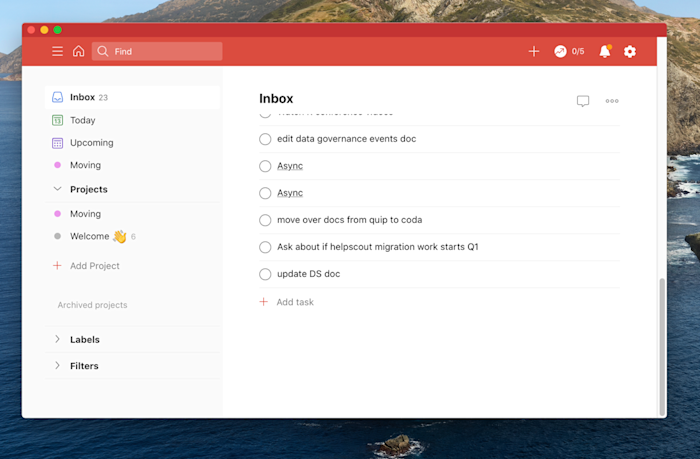
Todoist isn’t the most powerful to-do list out there. It’s also not the simplest. That’s kind of the point: this app balances power with simplicity, and it does so while running on basically every platform that exists. That’s a strong selling point—which is probably why Todoist is one of the most popular to-do lists right now, with over 10 million users.
Adding tasks was quick on every platform in our tests, thanks in part to natural language processing (type “buy milk Monday” and the task “buy milk” will be added with the next Monday set as your due date). You can put new tasks in your Inbox and then move them to relevant projects; you can also set due dates. Paid users can create custom filters and labels, and there are also some basic collaboration features.
Todoist is flexible enough to adapt to most workflows but not so complicated as to overwhelm. Overall, this is a great first to-do list app to try out, especially if you don’t know where to start.
Todoist integrates with Zapier, which means you can automatically create tasks in Todoist whenever something happens in one of your favorite apps. Here are some examples.
Todoist price: Free version available; paid version from $3/month
Microsoft To Do (Android, Windows, Web, iPhone and iPad)
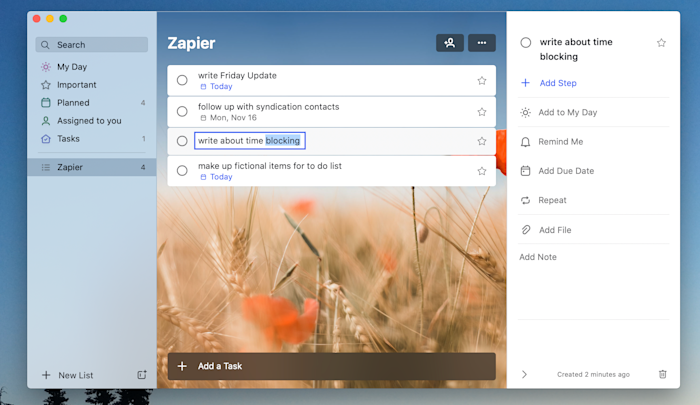
In 2015, Microsoft bought Wunderlist and put that team to work on a new to-do list app. Microsoft To Do is the result of that, and you can find Wunderlist’s DNA throughout the project. The main interface is clean and friendly, adding tasks is quick, but there’s a lot of flexibility below the surface.
But the real standout feature here is the deep integration with Microsoft’s ecosystem. Outlook users can sync their tasks from that application over to Microsoft To Do, meaning there is finally a way to sync Outlook tasks to mobile. Windows users can add tasks using Cortana or by typing in the Start menu. For example, you can type “add rice to my shopping list,” and rice will be added to a list called “shopping.”This is also the prettiest to-do list app on the market, in my opinion. You can set custom background images for every one of your lists, allowing you to tell at a glance which list you’re looking at. You’re going to be looking at your task list all day—it might as well look good.
Microsoft To Do integrates with Zapier, which means you can do things like create a task in To Do whenever important tasks pop up in your other apps. Here are some examples to get started.
Microsoft To Do price: Free
OmniFocus (macOS, iPhone, iPad)
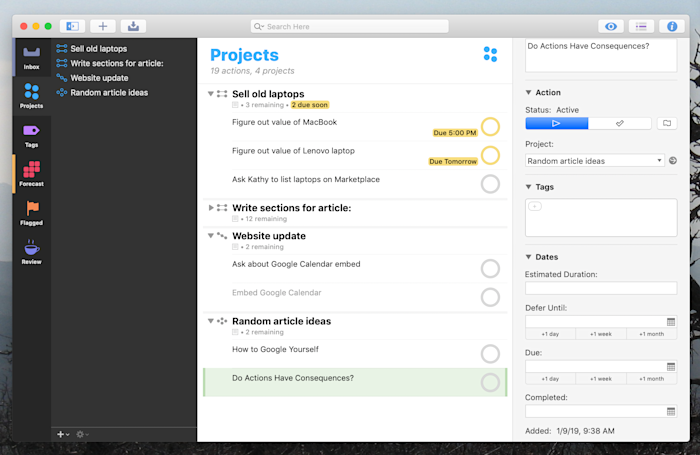
OmniFocus is nothing if not flexible. This Apple-exclusive application is built around the Getting Things Done (GTD) philosophy trademarked by David Allen, but an array of features means it can be used for just about any organizational system you can imagine. There are three different kinds of projects you can set up, for example, depending on whether you need to do tasks in a specific order or not. There are six main views by default, allowing you to organize your tasks by things like due date, projects, and tags. You can even add more views, assuming you have the Pro version.
You get the idea. OmniFocus is a power user’s dream, with more features than anyone can hope to incorporate into a workflow, which is kind of the point: if there’s a feature you want, OmniFocus has it, so you can organize your tasks basically any way you can imagine.
Syncing is offered only between Apple devices. There is a web version, currently in testing, but it’s intended for occasional usage away from your Apple machines more than anything else. Non-Apple users should look elsewhere.
You can connect OmniFocus to your other favorite apps with OmniFocus’s Zapier integration. Whenever something happens in another app that you want to keep track of in OmniFocus, Zapier will automatically send it there.
OmniFocus price: From $99.99 per year for recurring plan. Also available as a one-time purchase from $39.99 (14-day free trial).
Google Tasks (Web, Android, iPhone and iPad)
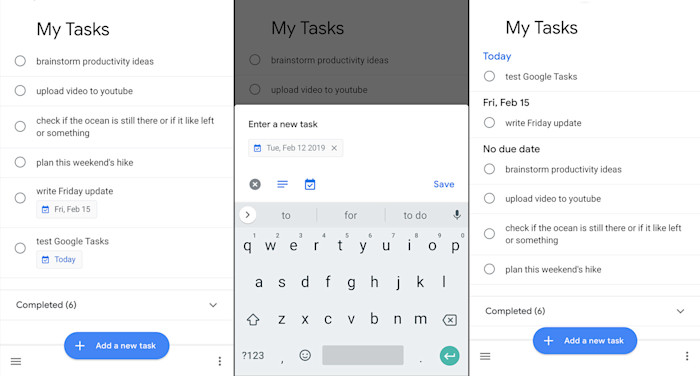
Gmail and Google Calendar have long offered an integrated tasks list, but for a long time, there was no way to access those tasks on mobile. Google Tasks changed that, offering an Android and iOS version to complement the web version.
The app itself is spartan. Adding tasks is quick, particularly if you spend a lot of time in Gmail anyway, but there’s not a lot of organizational offerings. There are due dates, lists, subtasks, and not much else.
So this isn’t the most robust task list, but the best to-do app is one that’s always handy. If you’re the kind of person who always has Gmail open on your computer, it’s hard for any application to be handier than Google Tasks. The mobile versions make those tasks accessible on the go.
You can automatically move information between Google Tasks and your other apps with Google Tasks’ integration on Zapier. Here are a few examples of workflows you can automate, so you can stop manually moving your tasks.
Google Tasks price: Free
Any.do (Android, iPhone and iPad, Web)
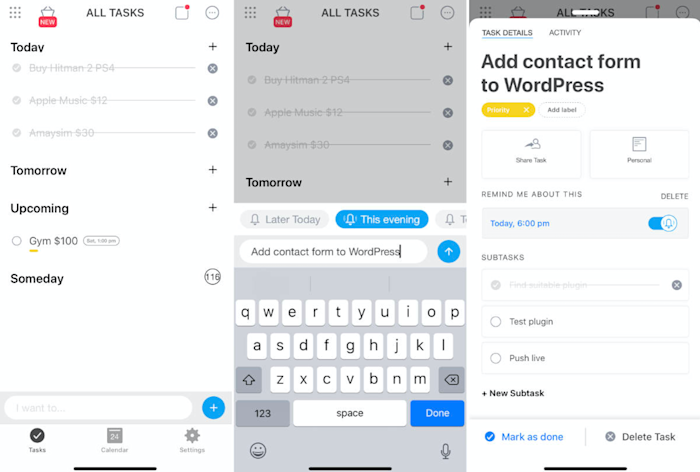
Any.do offers a really slick mobile app that makes it quick to add tasks, organize them into lists, and add due dates. But where it really shines is with its daily “Plan my Day” feature, which forces you to schedule when you’ll accomplish your various tasks so that you remember to actually do things. Any.do also integrates nicely with Google and Outlook calendars, allowing you to see your appointments and your tasks in one place. This is exactly what you need if you’re the kind of person who adds things to a list and forgets about them.
The desktop version isn’t quite as slick as the mobile version—it can feel cluttered, and doesn’t offer much in the way of keyboard shortcuts. Still, Any.do’s mobile version alone makes a compelling reason to give it a shot, especially if that’s where you do most of your task management.
Any.do integrates with Zapier, so you can automatically add tasks to Any.do whenever there’s a new calendar event, note, or task in your other apps.
Any.do price Free version available; paid version from $2.99/month
nTask
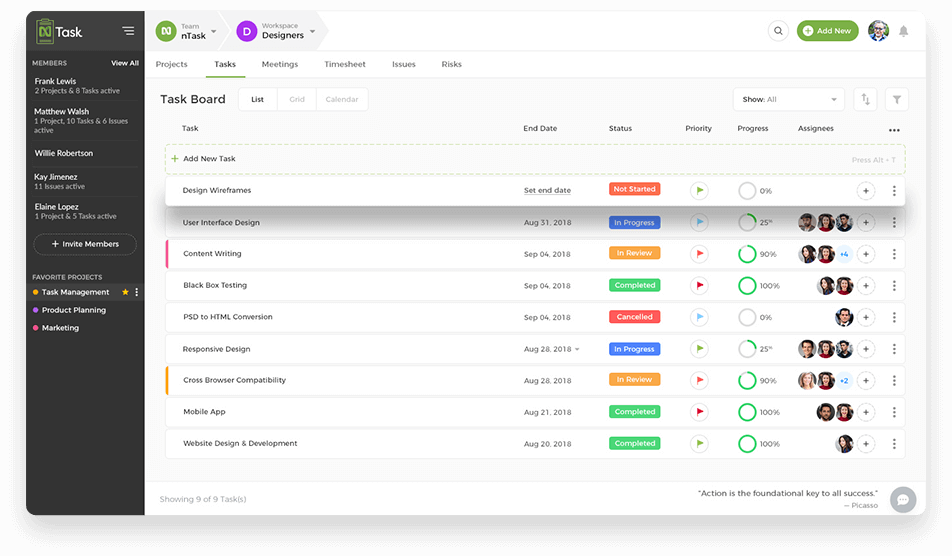
nTask comes first on our list of best to-do list apps. nTask is one of the best task management tools created for individuals and teams. With its simplified, user-friendly GUI letting you navigate a powerful set of features, nTask stands out of the crowd when it comes to helping with task completion.
You can create tasks and subtasks and schedule them as single-time, or recurring tasks. Through checklists, you can list down the things to be done. Moreover, you can create projects and associate multiple tasks under them. You can organize, prioritize tasks and monitor task status.
Options such as progress reports, timelines, and Gantt Charts let you keep projects on track. nTask helps you to save time with powerful search and filter options. You can search for tasks, projects, meetings, and do lots more. In addition, there are pre-saved filters to save time and effort on the end-users part.
This app also helps you stay in sync with updates and keeps you and your team on track through reminders and alerts.
Key Features
Out of its vast feature set nTask has to offer, here is a glimpse of some of its core features:
- Create, assign, organize, prioritize and share tasks.
- Schedule recurring meetings.
- Create and schedule recurring tasks.
- Manage tasks and to do lists with Kanban Boards.
- Create and assign projects.
- Comment on and assign tasks to projects or structure them independently.
- Convert comments to tasks using Slack.
- Select from multiple statuses for a task.
- Alerts, notifications, and reminders to keep teams on track.
- Two-Factor Authentication for extensive security.
- A simple user interface with access to a wide range of modules.
- Team specific workspaces that can be managed and monitored simultaneously.
- Extensive project management resources including project reports, Gantt charts, and project timelines to manage and monitor project progress.
- A dedicated time tracking module with the option of creating and managing team-specific sections for employee task efforts and payroll.
- A detailed meeting management module to help teams stay in sync. You can arrange and schedule meetings, be it one time or recurring meetings. Plus, it lets you send invites to attendees, add meeting details and specify follow-up procedures.
- Issue management module to facilitate the identification and listing down of issues related to multiple tasks. You can list down the issue along with the Issue owner and relevant details to track issue maintenance.
- Risk management module helps you identify and keep track of potential risks. You can list down the risk and assign a risk owner in order to track risk management.
- Powerful search and filter tools that help you search for tasks, projects, meetings, issues, and risks. You can even save more frequently used filters.
- Third-party integration with Zapier, Zoom, Google Calendar, Slack, and more.
- iOS and Android mobile apps.
Pros
- Comprehensive task management solution.
- Timesheets management for time tracking.
- Extensive meeting management module.
- Free version available.
- Set repeat tasks.
- To-Do List progress bar.
- Assign to-do lists to team members with due dates
Cons
- No desktop app is available for now.
- Advanced reporting will be released soon.
Pricing
- Free – Unlimited tasks, unlimited to-do lists, unlimited meetings, unlimited workspaces, timesheets, and more.
- Premium – Starting at $2.99 per month to unlock Gantt Charts and Projects – Plus all of the advanced nTask features.
- Business – Starting at $7.99 per month to unlock risk management, risk matrix, and permissions.
Conclusion
The key to keeping your work organized is having your to-dos listed out neatly. You have to commit to your list to actually get things done. A good to-do list app can help you manage what to do and schedule when to do your tasks. You can use your to-do list app for personal use or small teams that do not require comprehensive management features.
